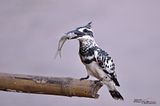

 A breeding adult Black-tailed Gull
A breeding adult Black-tailed Gull The Black-tailed Gulls are easy to identify. There were about 50 birds along with other species. I was a bit surprised to see that most of them were in their breeding plumages. Last time in around September, all of them were still in usual non-breeding plumages, so does it means that they will remain these beautiful plumages until spring? Since in April, they were all in breeding plumages also. There were few individuals in non-breeding plumage, and also one young juvenile, and an older immature. The juvenile Black-tailed is also the easiest one to identify. With its overall dark brown plumage, it stands out from the other whitish neighbors.

A juvenile Black-tailed Gull in flight
 Another individual, possessing some adult non-breeding features
Another individual, possessing some adult non-breeding features An adult Black-tailed Gull in full breeding plumage
An adult Black-tailed Gull in full breeding plumage The more common one was the Black-headed Gull. All of the birds were in their non-breeding plumages, except few juveniles. It is the smallest gull around here. In flight, it is easily identified by its white leading edges on the upperwings. The birds were very tame as usual, and came close to the sand beach. In spring, some will start molting into the breeding plumage, which will feature blackish-brown hood, dark red bill and feet.

A flock of non-breeding Black-headed Gull

 An immature Black-headed Gull
An immature Black-headed Gull
They were tame as usual.
The most problematic one was the Vega Gull. They are the biggest among the three species. As everyone knows, it is included in the Herring Gull complex, which is may be the most complicated form of sea gulls. The Vega is the easiest one to be found in Japan. Their characteristics include pink legs, and pale silvery-grey upperwings. But I found that there were plenty of variations, especially on the color of irises, legs, and the shape of bill, head, and body, which dragged me to complication. The typical ones have flesh pink legs with dark irises and reddish-orange orbital rings around the eyes, but lots of them had clear pale yellowish irises and orbital rings, and there were also individuals which showed the 'taimyrensis' characteristic, which regarded as Vega x Heuglin's Gull (Larus heuglini) in recent years, that is yellowish-pink legs. I don't have enough knowledge about these variations of the Vegas, so I couldn't go much further into the details. Well, let's see the pictures.


The 'taimyrensis' individual with yellowish-pink legs


Another 'taimyrensis' individual
 A group of pale-eyed Vega
A group of pale-eyed Vega
This one has very dense freckles, and dark eyes


Ouch!
 A second winter Vega Gull
A second winter Vega Gull

The same second winter individual stretching











.jpg)

No comments:
Post a Comment